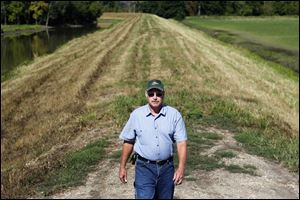
Proposal for Mississippi River would flood fields
Southern Missourians protest plan for levees farther north
8/16/2011
Geoff Sterne, whose 1,200-acre farm includes 750 in a floodplain, says that if a plan by the Army Corps of Engineers is carried out, 'it would kind of make us a dumping ground for everybody else.'
ANNADA, Mo. -- Another year, another "flood of the century" on the Mississippi River. But while the lower Mississippi has a plan for major flooding, the upper part of the nation's largest waterway is more subject to nature's whims.
Some river interests want to change that through "Plan H," an Army Corps of Engineers proposal to raise and upgrade most levees north of St. Louis. But many in Missouri are concerned because the plan would create something of a spillway in three northern Missouri counties, and politicians and residents there say they don't want to become a "dumping ground" for floodwaters.
"The people in our three counties are accustomed to taking in floodwater -- it happens every time the water comes down," Pike County Clerk Bob Kirkpatrick said. "But this is going to be shared. We're not going to take the flooding while people across the river have their fields and their towns protected."
Plan H was born out of years of study into the best way to tame the upper Mississippi, from where it begins as a trickle in Minnesota through its midway point near St. Louis. The upper river has roughly 140 levees.
Under Plan H, all but about 20 would be raised to protect against a 500-year flood -- a flood so severe it would be expected to occur only once every half-millennium.
The plan has some powerful supporters -- the Mississippi River Commission, the Upper Mississippi, Illinois, and Missouri River Association, and agricultural and political interests in Illinois. But even the corps refuses to endorse it, citing a low return on investment.
Virtually from the time the explorer Hernando De Soto crossed the Mississippi River in 1541, people have been trying to control it.
Flooding this year again showed that those efforts have produced mixed results. Crests topped record levels at many places in the lower half of the Mississippi, damaging or destroying thousands of homes and businesses.
Plan H focuses on making levees bigger and stronger.
Almost immediately, Missourians were in an uproar. By last year, a petition drive opposing Plan H drew 6,500 signatures. Politicians from both sides of the aisle -- including Democratic Gov. Jay Nixon and Republican U.S. Rep. Blaine Luetkemeyer, who represents the three counties -- expressed concerns.
Many details are yet to be worked out. One thing that isn't clear is how much additional water would flow to Missouri and south if bigger, stronger levees are built. Breached or overtopped levees allow the water to spread out. Missourians worry that the unbreakable funnel would cause flooding to be much worse here, threatening not only agricultural land but also unprotected river towns such as Clarksville and Elsberry.
Geoff Sterne's family has been farming in Pike County since the Great Depression. Now, his two sons, who are in their 20s, help him farm corn and soybeans on 1,200 acres, 750 of which are in the floodplain.
He has no interest in selling his land and watching it become a spillway. "I'm not opposed to a comprehensive plan. We just don't want to take all the water," Mr. Sterne said. "It would kind of make us a dumping ground for everybody else."